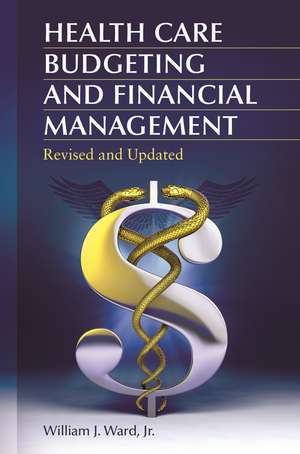Health Care Budgeting and Financial Management
Autor William J. Ward Jr.en Limba Engleză Paperback – 13 dec 2015 – vârsta până la 17 ani
| Toate formatele și edițiile | Preț | Express |
|---|---|---|
| Paperback (1) | 234.64 lei 22-36 zile | |
| Bloomsbury Publishing – 13 dec 2015 | 234.64 lei 22-36 zile | |
| Hardback (1) | 401.57 lei 43-57 zile | |
| Bloomsbury Publishing – 13 dec 2015 | 401.57 lei 43-57 zile |
Preț: 234.64 lei
Preț vechi: 278.86 lei
-16% Nou
Puncte Express: 352
Preț estimativ în valută:
44.91€ • 48.80$ • 37.75£
44.91€ • 48.80$ • 37.75£
Carte disponibilă
Livrare economică 31 martie-14 aprilie
Preluare comenzi: 021 569.72.76
Specificații
ISBN-13: 9781440844287
ISBN-10: 1440844283
Pagini: 480
Ilustrații: 50 bw illus
Dimensiuni: 156 x 235 x 30 mm
Greutate: 0.82 kg
Ediția:Revised
Editura: Bloomsbury Publishing
Colecția Praeger
Locul publicării:New York, United States
ISBN-10: 1440844283
Pagini: 480
Ilustrații: 50 bw illus
Dimensiuni: 156 x 235 x 30 mm
Greutate: 0.82 kg
Ediția:Revised
Editura: Bloomsbury Publishing
Colecția Praeger
Locul publicării:New York, United States
Caracteristici
Updates the highly regarded and widely used text, Health Care Budgeting and Financial Management for Non-Financial Managers
Notă biografică
William J. Ward, Jr., MBA, is associate professor of health finance and management at the Johns Hopkins Bloomberg School of Public Health and a former senior health care operational and financial executive.
Cuprins
PrefaceAcknowledgmentsIntroduction1. Welcome to Health Care and Financial Management
Defining Financial Management
Strategies for Success
Paradigms to Guide Performance
Today's Health Care Dilemma
The Public's Expectations
How Health Care Is Financed
Is There a Solution?
Critical Players in the Health Care Dilemma
The Real Problem
What Is Really Needed?
The Management Balancing Act
2. Basic Business and Accounting Concepts
Asset Valuation
The Purpose of Accounting
Approaches to Recording Transactions
Basic Terminology
Basic Accounting Concepts
Summary
3. Cost and Cost Behavior
Understanding Cost Behavior
The Nature of Operating Costs
Important Cost Concepts
Fixed versus Variable Costs
Real-World Implications
Direct and Indirect Costs
Cost Accounting
Manufacturing versus Health Care
Cost Accounting versus Financial Accounting
Accounting for Costs
Overhead Cost Allocation
The Fallacy of Cost Allocation
Important Caveats
4. Revenue and Reimbursement
Health Care Reimbursement Methodologies
Setting Prices
Billing and Collecting
Summary
5. Introduction to Budgeting
Budget Definition
A Detailed Plan
Resources
Acquiring and Using Resources
A Specific Time Period
A Plan for the Future
Formal and Measurable Terms
Types of Budgets
Reasons to Prepare a Budget
Who Prepares the Budget?
The Flow of Information
Important Planning Documents
Some Points to Keep in Mind
The Numbers Game
Justifying the Need
Where to Begin
Sources of Budget Information
6. The Operating Budget
Interrelationships
Sources of Information
An Orderly Approach
Statement of Goals and Objectives
The Volume Budget
The Revenue Budget
The Staffing Budget
Supplies and Services Budget
Base Period Adjustments
7. The Capital Budget
Capital Acquisition
The Questioning Technique
Capital Budget Review Committee
The Review Process
Packaging the Request
Justifying the Request
Selection Process
Making Balanced Decisions
Sources of Funds
Stretching Limited Funds
Constraints
8. The Cash Budget
Cash Inflows and Outflows
Roles in Budgeting and Managing Cash
Cash Flow Considerations
Conclusion
9. Financial Statements
The Balance Sheet
The Income Statement
The Cash Flow Statement
The Annual Audit
Examining the Financial Statements
Financial Ratios
Summary
10. Performance Measurement
Why Organizations Report on Performance
Characteristics of Good Performance Reports
Reading the Reports
How to Look at the Numbers
Some Important Points to Remember
Dashboards and Balanced Scorecards
The Value of the Dashboards
Strategic versus Operational
Rapidly Available, Reasonably Sound Data
Leading versus Trailing Indicators
Populating the Dashboard
Making Dashboards More Useful
Important Characteristics
One Final Choice
11. Analytical Tools
Variance Analysis
Types of Variances
When to Look
How to Look
Some Cautions
Forecasting
Decision Analyses
Working Backward
Gross versus Net Revenue
Ad Hoc Financial Analysis
Organizing the Financial Analysis
12. Improving Performance
Productivity
Factors That Influence Productivity
The Right Mind-Set
Benchmarking
Bilateral Performance Mapping
Process Flow Analysis
Productivity and Efficiency
Improving Efficiency
Managing Throughput
Resource Use Standards
A Final Thought
13. Revenue and Expense Strategies
Revenue Enhancement
Expense Control and Reduction
The Participative Approach
The Centralized Approach
14. Presenting Financial and Budget Data
Preparing for the Meeting
Presentation Qualities
Strategies for Budget Meeting Success
Developing a Business Plan
Implementation and Action Planning
15. The Business Case for Quality and Patient Safety
Connecting Clinical Quality Improvement and Financial Outcomes
The Process of Care
The Misleading Literature
The Health Care Business Model
Making the Pitch
Avoiding the Minefield
Points to Keep in Mind
16. Now What Do I Do?
Knowledge of the Business
Planning and Vigilance
A Businesslike Approach
The Desire to Manage
Obstacles to Success
Suggestions for Success
Changing Management Focus
17. Some Final Thoughts
The Challenge for Leaders and Managers
The Proper Role of the Government
Some IdeasAppendices1. Typical Audit Opinion Letter
2. Practice Problems
3. Practice Problems Solutions
4. Formulary
5. Present Value Table
6. Glossary
7. Major Diagnostic CategoriesIndex
